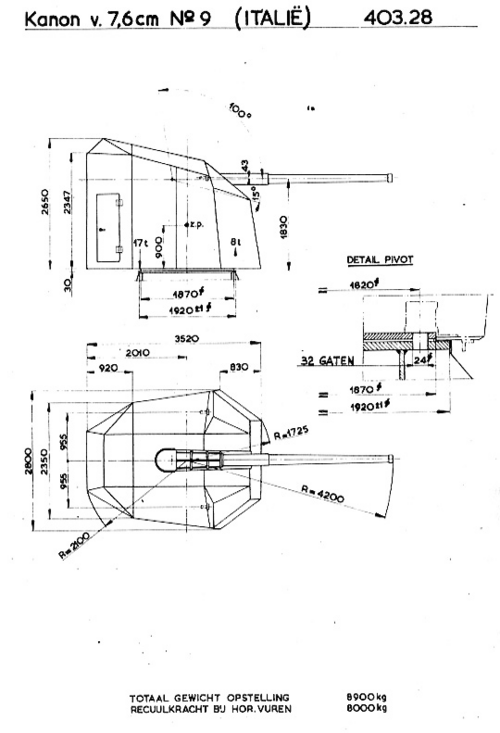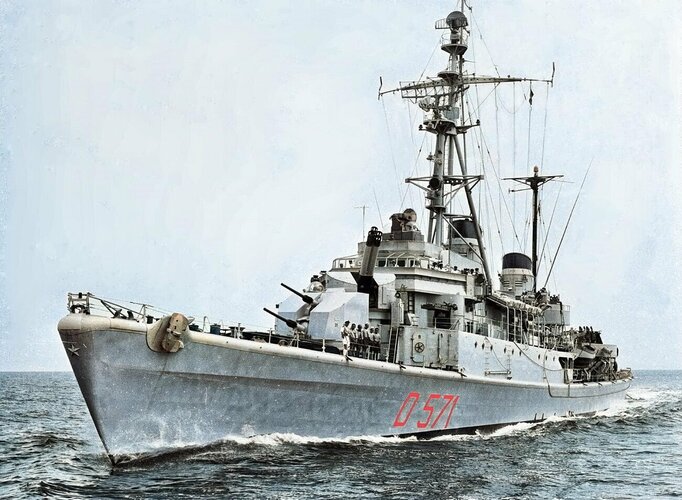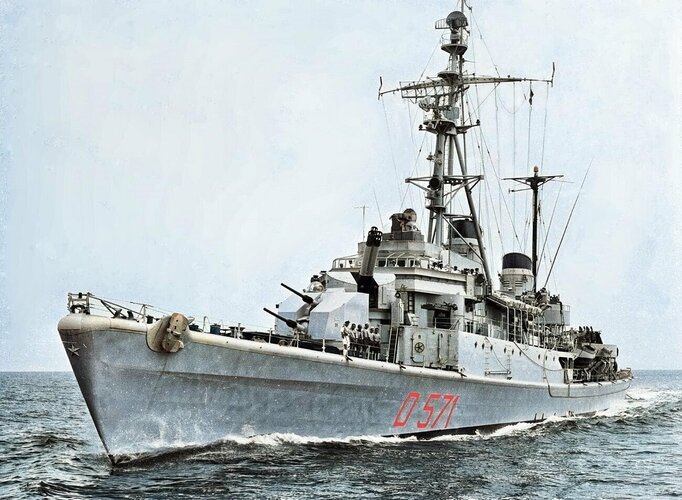Phoenix_jz
ACCESS: Confidential
- Joined
- 1 April 2020
- Messages
- 70
- Reaction score
- 247
Early 76mm/62 Naval Guns of the Marina Militare Italiana
Since little is written on these early 76mm guns developed in the 1950s, versus the more famous OTO-Melara 76/62 Compatto and Super Rapido, I figured I would create a post combining all the data available to me on these early Italian 76mm guns.
First – why the 76mm caliber?
After a period of initially introducing American weapon systems in or reusing wartime Italian gun systems on ships rebuilt or built in the early 1950s, the Marina Militare moved to develop their own gun systems. In the MMI's experience, the 40mm guns were simply too light – not effective against surface ships, and too small to accommodate a proximity fuse for greater efficiency against aircraft. Likewise, though the RM had made use of the American 5”/38, they found it too heavy to be mounted on frigates and corvettes (given their size at the time). They decided on the 76mm (3”) caliber as the best compromise, being the minimum caliber viable for a proximity fuse at that point in time and with the best combination of reactivity, hitting power, and rate of fire.
Thus in the early 1950s, the MMI issued specifications for a 76mm naval gun with a length of 62 calibers, offering better performance than the existing 3”/50 Mk.27 or Mk.33 of the from the United States.
SMP-3

The first establishment to respond to this and field a gun system was Stabilimenti Meccanici di Pozzuoli, of Naples, with the SMP-3. The name, fairly simply, stood for “Stabilimenti Meccanici di Pozzuoli, 3 pollici” (3 inches). This was a 76mm/62 weapon capable of elevating to +90° (or +100°), which fired a 6-kg shell at a muzzle velocity of 950 (Bargoni & Gay) to 959 m/s (Peluso) to achieve maximum range of 16,000 meters and maximum altitude of 11,500 meters.
The reloading system was a fairly complex, automatic system based on a ready drum. This drum, holding 14 rounds, would directly feed the gun, allowing for single-round fire or burst fire with a cyclical rate of 50 rpm. When the drum was to be replenished, the system would move to its maximum elevation, allowing for the rapid reloading of the drum, and then a return to the firing angle - with the entire process would take 3 seconds. The weapon system and mount came in at a collective 8.9 tonnes.
A total of 20 of these systems were built, exclusively equipping Albatros-class anti-submarine corvettes. Eight of these ships were ordered from Italian yards by the United States using funding under MDAP (Mutual Defense Assistance Program), for the navies of Italy (3), the Netherlands (1), and Denmark (4). These ships each mounted two guns – one fore, one aft – and slaved to a common director with a fire control radar. These were backed by a Breda Type 64 twin mount with two Bofors 40mm/70 AA guns. The MDAP ships were laid down in 1953-54 by Navalmeccanica (at Castellammare di Stabia), Breda Marghera (Venice) Cantieri del Tirreno (Riva Trigoso) and Cantiere Navali di Taranto (Taranto). A further pair was ordered independently by Indonesia, and were laid down in 1956 by Ansaldo at Livorno.
The whole class entered service from 1955 to 57, and the problems with the guns quickly became apparent. In particular, the weight of the drum and the speed at which it moved gave it a certain ‘inertia’, and the speed at which it was designed to be reloaded created room for error. On the sole Dutch ship – Lynx – a fatal accident occurred when a hitch occurred along the rollers when a 76mm cartridge was being introduced into the drum, jamming it into position. Friction from the rollers overheated the cartridge, causing a deflagration of the propellant charge and multiple casualties. The cause was ultimately put down to incorrect or excessive lubrication, but overall the experience proved emblematic of the complexity of the gun system. Another strike against it was the limited size of the Albatros-class corvettes – just 800 tons standard and 950 tons at full load – and their overall overweight. The Dutch ultimately returned their corvette to the United States after just five years of service, who then passed it to Italy to be commissioned as their fourth corvette in the class. From 1960 to 1963, all the Italian and Danish ships had their armament stripped (including the Breda Type 64 mount) and replaced. The Italians would opt to fit three Breda 40/70 Type 107 single mounts, while the Danish fited two American 3”/50 Mk.34 single mounts and a Bofors SAK 315 40/70 single mount.
The SMP-3 would remain in service on the Indonesian corvettes for another decade and a half. Both ships were then refit in 1976-77, with their entire Western armament being removed and replaced by Soviet weapon systems (including two 85mm/52 90-K, a pair of 25/80 2M-3M twin mounts, and two 14.5mm MG twin mounts).
Internal diagram of the SMP-3:

A Dutch external diagram - many thanks to @Sanglune for this one:
OTO-Melara 76/62 Sovrapposto

OTO-Melara’s first try at the gun caliber was a twin mount, with a unique ‘stacked’ approach (Sovrapposto meaning 'Superimposed') to the gun mount explicitly meant to allow the growth room to a quadruple mount. This was done with the understanding the Marina Militare intended to fit quadruple 76mm gun mounts to the light cruiser Giuseppe Garibaldi (C 551), which in the early 1950s was slated to be converted to an anti-aircraft cruiser. This project was later replaced by the proposal to rebuild her into a Guided Missile Cruiser, executed from 1957 to 1961.
This 76/62 would also fire a 6-kg shell, though different sources disagree about muzzle velocity and range. Bargoni & Gay give a muzzle velocity of 950 m/s and a maximum range of 16,000 meters, while Pignato & co. give a muzzle velocity of 925 m/s, and confusingly give the maximum range as 16,000 meters in text, and 16,300 meters in an appendix table. Maximum elevation also remains something of a debate, with Bargoni & Gay giving an elevation of up to +90°, while Pignato & co. give +85°. Maximum altitude is only given by Bargoni & Gay, as 11,500 meters. Unfortunately, no figure is available for the mass of this twin mount.
A major innovation by OTO-Melara on this gun mount – aside from the ‘stacked’ mounting of the guns – is the reloading system. OTO-Melara adopted a system of paired oscillating arms that would pick up rounds from revolving carousel at the base of the mount (11 rounds - itself fed by a hoist coming up from the magazines) and bring them up to the oscillating mass of the gun system. From there, a pair of pawls move the rounds along an articulated parallelogram trajectory to ensure stability when the cartridge is rammed into the breech. This system allowed for continuous loading of the gun at any angle. This was a major improvement on the SMP-3, which needed to move to maximum elevation to reload its ammunition drum - the very process that caused so many issues in service, as well as notable interruptions in firing. The rate of fire achieved by the 76/62 Sovrapposto is generally reported in the range of 50-60 rounds per minute - Bargoni & Gay give exactly this range, while both Peruso and Pignato & co. give 60 rpm. Cosentino and Brescia fall in the middle, reporting 55 rpm.
Production of this mount was limited - in part because of the limited stowage of ready rounds, but also difficulties in maintaining the system and the fact the system did not work perfectly in practice. Additionally, the high rate of fire and continuous feed meant that at full rate of fire, it was necessary to pause firing every 50-60 rounds for about ten seconds, to allow the barrels to cool sufficiently. Only eight of the 76/62 Sovrapposto complexes were built, serving on the four Centauro-class anti-submarine frigates (from 13 May 1957 – originally they were classed as Avvisi Scorta, which was a term equivalent to ‘Destroyer Escort’). These vessels were laid down from 1952-55, and entered service from 1957-58. Despite the problems with the weapons, the Marina Militare was satisfied enough with their performance to retain them for their first twelve years of service. The mounts would ultimately be removed only during the general mid-life upgrade of the class carried out progessively from 1966 to 1973, replacing them with the…
OTO-Melara 76/62 Allargato

The definitive version of the gun systems developed in the 1950s, development on the Allargato ('Enlarged') was initiated in the latter half of the decade, with the first examples entering service on the rebuilt guided missile cruiser Giuseppe Garibaldi in 1961. This gun system retains the same loading system as the earlier Sovrapposto, but in an 11.5-tonne single mount (12.1 tonnes with ammunition) with an expanded ready magazine – 43 rounds. Additionally, the barrel is water-cooled, allowing the full rate of fire to be sustained for longer periods. What exactly that rate of fire is, seems to be up for debate. Many of the common English-language sources give 60 rpm, but almost all the Italian sources disagree. Giorgerini & Nani's Gli Incrociatori Italiani gives 65 rpm, while Bargoni & Gay gives 70-80 rpm. Pignato & co. cite a flat 80 rpm.

This gun would go on to see widespread service in the Marina Militare, with a total of 87 complexes built. Garibaldi and the later helicopter guided missile cruisers - Andrea Doria, Caio Duilio, and Vittorio Veneto - would each mount eight, while the destroyer leader San Giorgio would mount three after her reconstruction from 1963-65. The two Impavdio-class guided destroyers would mount four each, and the two Alpino-class frigates six each. Likewise the four Carlo Bergamini-class frigates would mount three each, and the Centauro-class frigates would mount the same number after their mid-life refits. Finally, the four De Cristoforo-class corvettes would each mount two. Even long past when all these ships left service, the gun remains in service – pulled off decommissioned ships and remounted on the two Stromboli-class AORs and the four Cassiopea-class OPVs (one each for both classes).
As of the time of writing (October 2024), five examples of the gun remain in service. These are on the four Cassiopea-class OPVs, and Stromboli herself (her sister, Vesuvio, was decommissioned on 11 October 2023). With Stromboli herself due for replacement relatively soon (probably 2025 when the LSS Atalante enters service), and the Cassiopea likely to be the first of the OPVs to be replaced by the upcoming PPX (starting in 2027), it is likely that this will be the last decade of service for the venerable gun system, and that no examples will remain in service after 2031/32. This would still be an impressive 70 years after its introduction.
The development of an even lighter 76/62 with greater reliability and responsiveness (as well as a higher rate of fire and greater on-mount ammunition capacity) commenced soon after the introduction of the 76/62 Allargato. This would dead to the production of the very famous 76/62 Compatto (Compact), which would go on to equip vessels as large as amphibious assault ships (and even aircraft carriers, in the later Super Rapido version!) to as small as fast attack craft, and see ubiquitous service with not just the Marina Militare, but across the globe as the most widely exported naval gun system of the modern era. But that is a story that is very well known, and does not need its own secret projects entry...
Sources
Bargoni, Franco & Franco Gay - Esplotatori, Fregate, Corvette Ed Avvisi Italiani 1861-1968 (1970)
Cosentino, Michele & Maurizio Brescia - Storia Militare Dossier No.16: La Marina Italiana 1945-2015, Parte 1a, 1945-1970 (2014)
Giorgerini, Giorgio & Augusto Nani - Gli Incrociatori Italiani 1861-1970, 3a edizione (1971)
Peluso, Giuseppe - 'SMP-3: l'ultimo cannone di Pozzuoli', Appuntamento con la Storia (2012?)
Pignato, F., F. Cappellao, A. Rastelli - OTO Melara 1905-2005: Una Grande Tradizione Verso Il Futuro (2005)
Since little is written on these early 76mm guns developed in the 1950s, versus the more famous OTO-Melara 76/62 Compatto and Super Rapido, I figured I would create a post combining all the data available to me on these early Italian 76mm guns.
First – why the 76mm caliber?
After a period of initially introducing American weapon systems in or reusing wartime Italian gun systems on ships rebuilt or built in the early 1950s, the Marina Militare moved to develop their own gun systems. In the MMI's experience, the 40mm guns were simply too light – not effective against surface ships, and too small to accommodate a proximity fuse for greater efficiency against aircraft. Likewise, though the RM had made use of the American 5”/38, they found it too heavy to be mounted on frigates and corvettes (given their size at the time). They decided on the 76mm (3”) caliber as the best compromise, being the minimum caliber viable for a proximity fuse at that point in time and with the best combination of reactivity, hitting power, and rate of fire.
Thus in the early 1950s, the MMI issued specifications for a 76mm naval gun with a length of 62 calibers, offering better performance than the existing 3”/50 Mk.27 or Mk.33 of the from the United States.
SMP-3
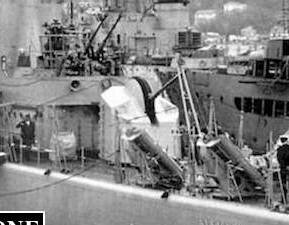
The first establishment to respond to this and field a gun system was Stabilimenti Meccanici di Pozzuoli, of Naples, with the SMP-3. The name, fairly simply, stood for “Stabilimenti Meccanici di Pozzuoli, 3 pollici” (3 inches). This was a 76mm/62 weapon capable of elevating to +90° (or +100°), which fired a 6-kg shell at a muzzle velocity of 950 (Bargoni & Gay) to 959 m/s (Peluso) to achieve maximum range of 16,000 meters and maximum altitude of 11,500 meters.
The reloading system was a fairly complex, automatic system based on a ready drum. This drum, holding 14 rounds, would directly feed the gun, allowing for single-round fire or burst fire with a cyclical rate of 50 rpm. When the drum was to be replenished, the system would move to its maximum elevation, allowing for the rapid reloading of the drum, and then a return to the firing angle - with the entire process would take 3 seconds. The weapon system and mount came in at a collective 8.9 tonnes.
A total of 20 of these systems were built, exclusively equipping Albatros-class anti-submarine corvettes. Eight of these ships were ordered from Italian yards by the United States using funding under MDAP (Mutual Defense Assistance Program), for the navies of Italy (3), the Netherlands (1), and Denmark (4). These ships each mounted two guns – one fore, one aft – and slaved to a common director with a fire control radar. These were backed by a Breda Type 64 twin mount with two Bofors 40mm/70 AA guns. The MDAP ships were laid down in 1953-54 by Navalmeccanica (at Castellammare di Stabia), Breda Marghera (Venice) Cantieri del Tirreno (Riva Trigoso) and Cantiere Navali di Taranto (Taranto). A further pair was ordered independently by Indonesia, and were laid down in 1956 by Ansaldo at Livorno.
The whole class entered service from 1955 to 57, and the problems with the guns quickly became apparent. In particular, the weight of the drum and the speed at which it moved gave it a certain ‘inertia’, and the speed at which it was designed to be reloaded created room for error. On the sole Dutch ship – Lynx – a fatal accident occurred when a hitch occurred along the rollers when a 76mm cartridge was being introduced into the drum, jamming it into position. Friction from the rollers overheated the cartridge, causing a deflagration of the propellant charge and multiple casualties. The cause was ultimately put down to incorrect or excessive lubrication, but overall the experience proved emblematic of the complexity of the gun system. Another strike against it was the limited size of the Albatros-class corvettes – just 800 tons standard and 950 tons at full load – and their overall overweight. The Dutch ultimately returned their corvette to the United States after just five years of service, who then passed it to Italy to be commissioned as their fourth corvette in the class. From 1960 to 1963, all the Italian and Danish ships had their armament stripped (including the Breda Type 64 mount) and replaced. The Italians would opt to fit three Breda 40/70 Type 107 single mounts, while the Danish fited two American 3”/50 Mk.34 single mounts and a Bofors SAK 315 40/70 single mount.
The SMP-3 would remain in service on the Indonesian corvettes for another decade and a half. Both ships were then refit in 1976-77, with their entire Western armament being removed and replaced by Soviet weapon systems (including two 85mm/52 90-K, a pair of 25/80 2M-3M twin mounts, and two 14.5mm MG twin mounts).
Internal diagram of the SMP-3:
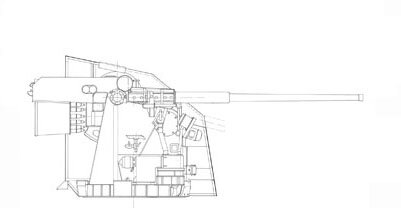
A Dutch external diagram - many thanks to @Sanglune for this one:
OTO-Melara 76/62 Sovrapposto
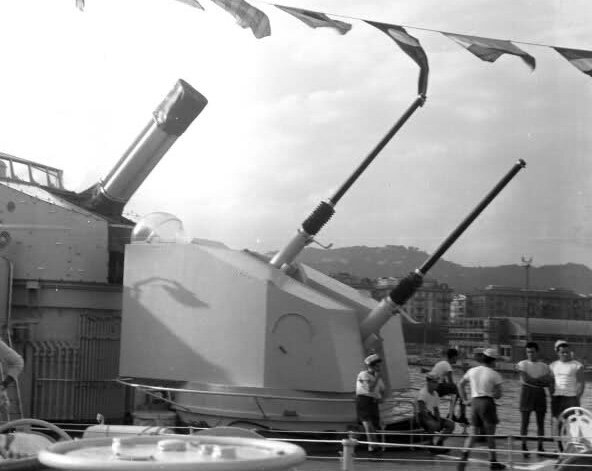
OTO-Melara’s first try at the gun caliber was a twin mount, with a unique ‘stacked’ approach (Sovrapposto meaning 'Superimposed') to the gun mount explicitly meant to allow the growth room to a quadruple mount. This was done with the understanding the Marina Militare intended to fit quadruple 76mm gun mounts to the light cruiser Giuseppe Garibaldi (C 551), which in the early 1950s was slated to be converted to an anti-aircraft cruiser. This project was later replaced by the proposal to rebuild her into a Guided Missile Cruiser, executed from 1957 to 1961.
This 76/62 would also fire a 6-kg shell, though different sources disagree about muzzle velocity and range. Bargoni & Gay give a muzzle velocity of 950 m/s and a maximum range of 16,000 meters, while Pignato & co. give a muzzle velocity of 925 m/s, and confusingly give the maximum range as 16,000 meters in text, and 16,300 meters in an appendix table. Maximum elevation also remains something of a debate, with Bargoni & Gay giving an elevation of up to +90°, while Pignato & co. give +85°. Maximum altitude is only given by Bargoni & Gay, as 11,500 meters. Unfortunately, no figure is available for the mass of this twin mount.
A major innovation by OTO-Melara on this gun mount – aside from the ‘stacked’ mounting of the guns – is the reloading system. OTO-Melara adopted a system of paired oscillating arms that would pick up rounds from revolving carousel at the base of the mount (11 rounds - itself fed by a hoist coming up from the magazines) and bring them up to the oscillating mass of the gun system. From there, a pair of pawls move the rounds along an articulated parallelogram trajectory to ensure stability when the cartridge is rammed into the breech. This system allowed for continuous loading of the gun at any angle. This was a major improvement on the SMP-3, which needed to move to maximum elevation to reload its ammunition drum - the very process that caused so many issues in service, as well as notable interruptions in firing. The rate of fire achieved by the 76/62 Sovrapposto is generally reported in the range of 50-60 rounds per minute - Bargoni & Gay give exactly this range, while both Peruso and Pignato & co. give 60 rpm. Cosentino and Brescia fall in the middle, reporting 55 rpm.
Production of this mount was limited - in part because of the limited stowage of ready rounds, but also difficulties in maintaining the system and the fact the system did not work perfectly in practice. Additionally, the high rate of fire and continuous feed meant that at full rate of fire, it was necessary to pause firing every 50-60 rounds for about ten seconds, to allow the barrels to cool sufficiently. Only eight of the 76/62 Sovrapposto complexes were built, serving on the four Centauro-class anti-submarine frigates (from 13 May 1957 – originally they were classed as Avvisi Scorta, which was a term equivalent to ‘Destroyer Escort’). These vessels were laid down from 1952-55, and entered service from 1957-58. Despite the problems with the weapons, the Marina Militare was satisfied enough with their performance to retain them for their first twelve years of service. The mounts would ultimately be removed only during the general mid-life upgrade of the class carried out progessively from 1966 to 1973, replacing them with the…
OTO-Melara 76/62 Allargato
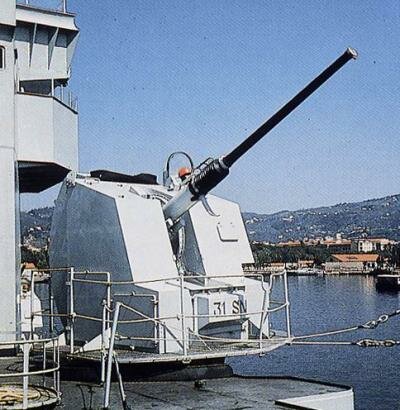
The definitive version of the gun systems developed in the 1950s, development on the Allargato ('Enlarged') was initiated in the latter half of the decade, with the first examples entering service on the rebuilt guided missile cruiser Giuseppe Garibaldi in 1961. This gun system retains the same loading system as the earlier Sovrapposto, but in an 11.5-tonne single mount (12.1 tonnes with ammunition) with an expanded ready magazine – 43 rounds. Additionally, the barrel is water-cooled, allowing the full rate of fire to be sustained for longer periods. What exactly that rate of fire is, seems to be up for debate. Many of the common English-language sources give 60 rpm, but almost all the Italian sources disagree. Giorgerini & Nani's Gli Incrociatori Italiani gives 65 rpm, while Bargoni & Gay gives 70-80 rpm. Pignato & co. cite a flat 80 rpm.
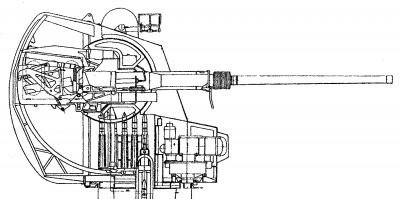
This gun would go on to see widespread service in the Marina Militare, with a total of 87 complexes built. Garibaldi and the later helicopter guided missile cruisers - Andrea Doria, Caio Duilio, and Vittorio Veneto - would each mount eight, while the destroyer leader San Giorgio would mount three after her reconstruction from 1963-65. The two Impavdio-class guided destroyers would mount four each, and the two Alpino-class frigates six each. Likewise the four Carlo Bergamini-class frigates would mount three each, and the Centauro-class frigates would mount the same number after their mid-life refits. Finally, the four De Cristoforo-class corvettes would each mount two. Even long past when all these ships left service, the gun remains in service – pulled off decommissioned ships and remounted on the two Stromboli-class AORs and the four Cassiopea-class OPVs (one each for both classes).
As of the time of writing (October 2024), five examples of the gun remain in service. These are on the four Cassiopea-class OPVs, and Stromboli herself (her sister, Vesuvio, was decommissioned on 11 October 2023). With Stromboli herself due for replacement relatively soon (probably 2025 when the LSS Atalante enters service), and the Cassiopea likely to be the first of the OPVs to be replaced by the upcoming PPX (starting in 2027), it is likely that this will be the last decade of service for the venerable gun system, and that no examples will remain in service after 2031/32. This would still be an impressive 70 years after its introduction.
The development of an even lighter 76/62 with greater reliability and responsiveness (as well as a higher rate of fire and greater on-mount ammunition capacity) commenced soon after the introduction of the 76/62 Allargato. This would dead to the production of the very famous 76/62 Compatto (Compact), which would go on to equip vessels as large as amphibious assault ships (and even aircraft carriers, in the later Super Rapido version!) to as small as fast attack craft, and see ubiquitous service with not just the Marina Militare, but across the globe as the most widely exported naval gun system of the modern era. But that is a story that is very well known, and does not need its own secret projects entry...
Sources
Bargoni, Franco & Franco Gay - Esplotatori, Fregate, Corvette Ed Avvisi Italiani 1861-1968 (1970)
Cosentino, Michele & Maurizio Brescia - Storia Militare Dossier No.16: La Marina Italiana 1945-2015, Parte 1a, 1945-1970 (2014)
Giorgerini, Giorgio & Augusto Nani - Gli Incrociatori Italiani 1861-1970, 3a edizione (1971)
Peluso, Giuseppe - 'SMP-3: l'ultimo cannone di Pozzuoli', Appuntamento con la Storia (2012?)
Pignato, F., F. Cappellao, A. Rastelli - OTO Melara 1905-2005: Una Grande Tradizione Verso Il Futuro (2005)
Attachments
Last edited:

